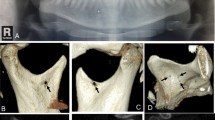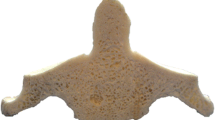Abstract
The normal flexibility in morphology and topography of body structures may be termed as an anatomical variation. This manuscript, aims to present a unique discovery of ‘coronoid foramina’ bilaterally along with bilateral accessory foramina over the ‘lateral aspect of the ramus of the mandible’ which has never been seen or documented in the literature so far in a live patient. It is noteworthy to realize a trait of phylogenetic context in these discoveries.






Similar content being viewed by others
References
Anderson S (1991) A comparative study of the human skeletal material from late first and early second millennium sites in the North-East of England. Thesis, Univ. Durham. Non-metric traits, pp 73–74. http://www.spoilheap.co.uk/hsrpapers.htm. Accessed 9 Jan 2018
Cunningham DJ (1898) The significance of anatomical variations. J Anat Physiol 33(Pt 1):1–9. https://www.ncbi.nlm.nih.gov/pmc/articles/PMC1327970/. Accessed 9 Jan 2018
Dixon AF (1912) Manual of human osteology. Oxford University Press, London, pp 196–198
Duckworth WLH, Lyons MC, Towers B (1962) (eds) Galen on anatomical procedures: the later books. Cambridge University Press, Cambridge
Fabian FM (2006) Observation of the position of the linguala in relation to the mandibular foramen and the mylohyoid groove. Ital J Anat Embryol 111(3):151–158. https://www.ncbi.nlm.nih.gov/pubmed/17312921. Accessed 9 Jan 2018
Fawcett E (1895) The structure of the inferior maxilla with special reference to the position of the inferior dental canal. J Anat Physiol 29:355–366. https://www.ncbi.nlm.nih.gov/pmc/articles/PMC1328410/. Accessed 9 Jan 2018
Ferretti MP, Debruyne R (2011) Anatomy and phylogenetic value of the mandibular and coronoid canals and their associated foramina in proboscideans (Mammalia). Zool J Linn Soc 161:391–413. https://doi.org/10.1111/j.1096-3642.2010.00637.x
Gray H, Williams PL, Bannister LH, Berry MM, Collins P, Dyson M, Dussek JE, Ferguson MWJ et al (1995) Gray’s anatomy, 38th edn. Churchill Livingstone, London, pp 576–577
Harminder SD (2014) The power of observation. Arq Bras Oftalmol, vol 77, no 5, Sao Paulo. https://doi.org/10.5935/0004-2749.20140069
Kaufman E, Serman NJ, Wang PD (2000) Bilateral mandibular accessory foramina and canals: a case report and review of the literature. Dento Maxillofac Radiol 29:170–175. http://www.birpublications.org/doi/pdf/10.1038/sj/dmfr/4600526. Accessed 9 Jan 2018
Przystanska A, Bruska M (2012) Anatomical classification of accessory foramina in human mandibles of adults, infants and foetuses. Anat Sci Int 87:141. https://doi.org/10.1007/s12565-012-0136-z
Squires M (2002) Lady Chatterley’s lover; a propos of Lady Chatterley’s Lover/Lawrence DH. Cambridge University Press, United Kingdom, p 18
Stacy Ralph W, Bruce D, Waxman (eds) (1965) Computers in biomedical research, vol 1. Academic Press, New York, p 320
Sutton RN (1974) The practical significance of mandibular accessory foramina. Aust Dent J 19:167–173. https://doi.org/10.1111/j.1834-7819.1974.tb05034.x
Tassy P, Shoshani J (1988) The tethytheria: elephants and their relatives. In: Benton MJ (ed) The phylogeny and classification of the tetrapods. Vol 2: mammals. systematics association special, vol 35B. Clarendon Press, Oxford, pp 283–315
Acknowledgements
The author thanks the patient for his kind co-operation in the investigations and the consent rendered to illustrate the findings in the manuscript.
Funding
There was no funding for this study.
Author information
Authors and Affiliations
Corresponding author
Ethics declarations
Conflict of interest
The author declares that there is no conflict of interest.
Ethical approval
All the findings were incidental and not planned procedural study. The patient was informed about the peculiar findings in him and an informed signed consent was taken with permission to use his data for research publication purposes.
Rights and permissions
About this article
Cite this article
Firdoose Chintamani Subhan, N. Bilateral ‘coronoid foramina’ with accessory foramina on the ‘lateral aspect of ramus’ of mandible: an unseen variance discovery in humans. Surg Radiol Anat 40, 641–646 (2018). https://doi.org/10.1007/s00276-018-1984-6
Received:
Accepted:
Published:
Issue Date:
DOI: https://doi.org/10.1007/s00276-018-1984-6




